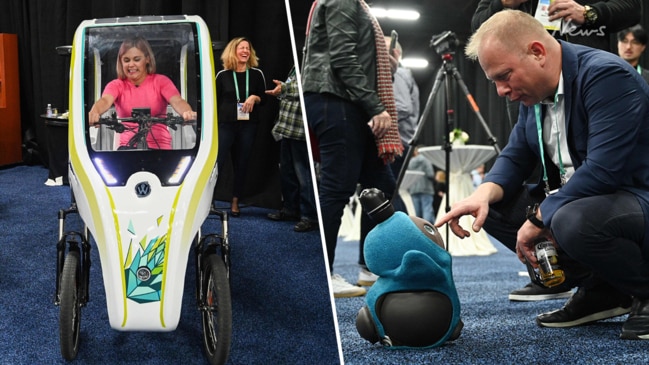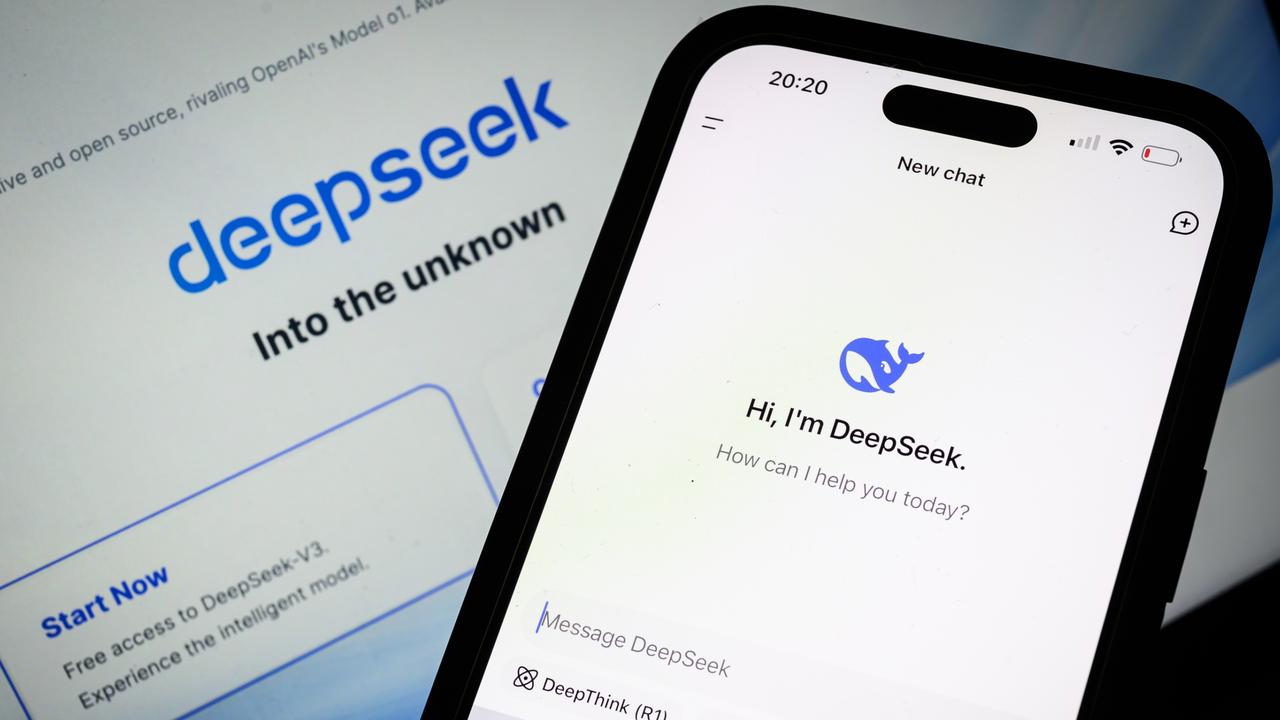CES 2020 is home to cutting edge technology from the future. It’s also given us the most bizarre presentation we’ve ever seen
A new technology firm wants to create realistic but entirely fake digital human beings. The question is: Should they?

Innovation
Don't miss out on the headlines from Innovation. Followed categories will be added to My News.
Sometimes the future is a little late.
Tuesday’s keynote address for the mysterious new Neon digital avatars backed by Samsung started behind schedule in the centre hall of the Las Vegas Convention Centre, the main site for the Consumer Electronics Show (CES).
Pranav Mistry, head of Samsung’s STAR Labs, apologised for the delay, citing some technical issues as the reason.
While the presentation was taking place on the floor of an expansive exhibition hall, rather than on the lavish stages that played host to bigger companies earlier in the week, there was no shortage of interest as technologists and enthusiasts from around the world gathered to get their first view of the much hyped artificial humans.
They were in for a treat.
NEON – Our first Artificial Human is here. #NEON #CES2020
— NEON (@neondotlife) January 7, 2020
Mr Mistry, well known for his work as a researcher at Google, Microsoft, and NASA before he joined Samsung Electronics in 2012, began the presentation with a story of his first time at CES six years ago, telling the audience his dream of demonstrating his own technology at the show while those assembled waited with bated breath for him to actually do so.
But first they were treated to more pieces of trivia.
The presentation began as many often do with a quote projected on the screen.
Unlike many others however, the quote Mr Mistry presented was from himself.
“Imagination is just a stopover to the next reality,” Mr Mistry said, reading out the quote from himself that he “truly believed”.
“If you can imagine, you can build it.”
It would later be followed by two other projected quotes throughout the presentation, both from Albert Einstein (after all the best company is the type you choose for yourself).
Finally we approached what everyone wanted to know, as Mr Mistry asked, “What is Neon?”
But first the audience would be given a brief explainer on the inspiration behind the company name.
Flying to CES tomorrow, and the code is finally working :) Ready to demo CORE R3. It can now autonomously create new expressions, new movements, new dialog (even in Hindi), completely different from the original captured data. pic.twitter.com/EPAJJrLyjd
— Pranav Mistry (@pranavmistry) January 5, 2020
Neon, the tenth element on the periodic table, is an inert, odourless, colourless gas, that when electrified, glows.
The bash-you-over-the-head obvious metaphor is at least partially accurate, if only in spirit.
The Neon avatars are digital imitations of real human beings designed to take the cold nature of digital AI assistants and humanise them.
As Mr Mistry put it, the goal of the Neon avatars is to bridge the gap between AI technology and actual human beings, creating friendly and responsive avatars that feel real without falling into the uncanny valley where they instead become creepy.
He likened the characters and how he hopes we’ll eventually interact with them to the same way we can empathise with characters in books or movies, or with social media influencers, who despite what you may think of them, are in fact real human beings for the most part.
In order for a Neon to work, Mr Mistry detailed, it would have to satisfy three Rs: reality, real time, and responsive.
They would have to look like real human beings, and for the most part they do, provided you overlook they are still bound to a screen.
They would have to be able to work in real time and be responsive in real time, and there he boasted latencies in the range of 20 milliseconds.
“It might be about the same time because your brain understands what you’re seeing and sends it back,” Mr Mistry said.
“Neon’s are responsive, they listen to us.”
Pranav presented today about #CORER3 (Reality, Realtime, Responsive) Engine, the advanced technology behind #NEON. #CES2020 pic.twitter.com/6WTWvRZ8uF
— NEON (@neondotlife) January 8, 2020
Recent failings and missteps in the industry now requires all technology visionaries to assure audiences that privacy is at the heart of everything they do, and Mr Mistry also made passing reference to the elusive concept but didn’t expand beyond a few brief platitudes.
Finally it was time to see the Neons in action.
Another member of the Neon team came to the stage, picking up a tablet as three Neons, ever so slightly different looking renderings of a young woman in the guise of an airline worker, yoga instructor and student filled the screens.
“Please bear with me on this thing because this is the first time we are doing public previews of our system,” Mr Mistry said forebodingly.
The airline worker Neon was then ordered to give a smile, before being told to look confused and obligingly providing an imitation of the emotion that would have been more at home in a community theatre production.
Next up was the yoga instructor, who was asked to say something.
“Are you having fun?” The yoga instructor asked in a concerned tone of voice far removed from the calming cadence they are usually known for.
Finally the student Neon was asked to give a little laugh, which it actually produced quite realistically, before its artificially rendered face snapped back to a stern neutral expression.
“Every Neon has their own personality built-in,” the audience heard.
The demonstration then continued in the form of a conversation with another Neon, named Monica (despite laughing seconds earlier none of the Neons appeared to appreciate this little joke).
“Hi Monica, what are you? Are you human or what?”
“Hi,” Monica responded.
“I am Neon, I am an artificial human. I’m still learning about how humans talk, behave, and move,” Monica replied in a stilted digital cadence roughly similar to digital voice assistants like Siri or Alexa.
“As a Neon, how old are you?”
“That’s not really something I care about,” Monica said cooly.
“Okay, are there any other Neons at CES?”
“Yes, definitely,” Monica said, leaving a very human-like awkward pause before impressively continuing the small talk with a question of her own.
“Is this your first time to attend CES?” Monica asked.
“No I’ve been here a few times,” the demonstrator answered.
“But you’re the first Neon I’ve met. Tell me, I hear you can speak several languages?”
He continued, with a Dorothy Dixer that would make even the most irrelevant backbencher blush.
“Yes, that is absolutely right,” Monica responded, before obliging the demonstrator’s request to speak in Korean and Chinese (more trained ears may have even been able to differentiate if this was Cantonese or Mandarin).
This concluded the demonstration for the most part, beset as it was by similar technical difficulties that delayed the start of the keynote.
Mr Mistry then returned to his favoured position in the spotlight, detailing what he hopes for the future of the Neon technology, to become “an AI driven virtual being that is 100 per cent virtually real”.
The audience was assured Neon was “very unlike an AI assistant,” and could in the future be deployed as a retail worker, or even a teacher.
“They are more like friends and collaborators,” Mr Mistry claimed.
This was dependent on the future deployment of another technology called Spectra, which would combine with the Core R3 engine at the heart of Neon to add deep learning capabilities.
More details on Core R3 and Spectra were promised at a private event later this year, Neon World being poised to become yet another platform for brands to exclusively reveal their cutting edge tech they simply couldn’t possibly show off at the world’s biggest technology conference attended by the majority of the industry.
But before the presentation could end, the audience would be treated to a few more ideas in which Mr Mistry “truly believed”.
“There is two ways you can live in the future: one way is that you can wait for someone to build the future for you, or you can become that someone. At STAR Labs and Neon we believe that we should become that someone,” Mr Mistry said, after around half an hour of failing to demonstrate any tangible reason why that should be the case.
“Machines of tomorrow are going to get more and more powerful, there’s no doubt about it,” Mr Mistry said, beginning to wrap up the presentation of the technology he wants to see become his life’s work.
“It’s not about what we can design them to do, it’s more about what we should design them to do. Can we make them more like us rather than we becoming more like them?” Mr Mistry said.
In the words of many Las Vegas tourists and locals enjoying the state of Nevada’s now legal recreational marijuana: “whoa man”.
Are you as confused as we are right now? Let us know in the comments below
The reporter travelled to CES with assistance from LG and TCL
Originally published as CES 2020 is home to cutting edge technology from the future. It’s also given us the most bizarre presentation we’ve ever seen


